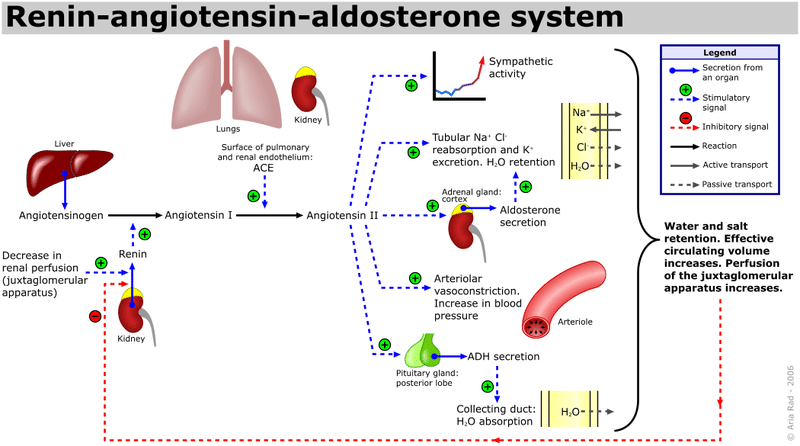Describe the Renin-angiotensin-aldosterone Pathway
Article in French Author A Mimran 1 Affiliation 1 Service de médecine interne et hypertension CHU. When there is a drop or rise in the blood pressure level of a person this system functions immediately by releasing renin into the bloodstream.

The Renin Angiotensin Aldosterone System Teachmephysiology
Whenever there is a drop in blood pressure within the body the kidneys produce an enzyme called renin that signals the body to constrict blood vessels increasing.

. Hypertension and the renin-angiotensin-aldosterone pathway Rev Med Interne. Plasma renin then carries out the. Every organ is affected by RAAS activation and the resultant.
The three hormones renin angiotensin II and aldosterone make up the majority of the system. Diabetes mellitus often results in. The reninangiotensin system or reninangiotensinaldosterone system is a hormone system that regulates blood pressure fluid and electrolyte balance and systemic vascular resistance.
Now 10 amino acids long angiotensin I continue to circulate until being acted upon by ACE. It is primarily governed by the rate o View the full answer. When renal blood flow is reduced juxtaglomerular cells in the kidneys convert the precursor prorenin into renin and secrete it directly into the circulation.
Kidney-secreted renin enzyme acts on its substrate to form angiotensin II a versatile effector peptide hormone. Primarily it is regulated by the rate of renal blood flow. The renin-angiotensin-aldosterone system RAAS or renin-angiotensin-system RAS is a regulator of blood pressure and cardiovascular function.
Why do you think this is such an important endocrine pathway. ADH angiotensin II aldosterone and ANP. AT2 and aldosterone inhibit release of renin.
Solution for Describe the renin-angiotensin-aldosterone pathway. Refer to Figure 13 in your lab manual. Refer to Figure 13 in your lab manual.
What are the stimuli for renin release. Manipulative therapies play a major role in treating heart failure and hypertension. The Renin-Angiotensin-Aldosterone System RAAS is a hormone system which regulates blood pressure and fluid balance.
Overall function Essential for fluid and electrolyte homeostasis and response to haemorrhage Angiotensin 2. The renin angiotensin aldosterone system RAAS controls blood pressure and glomerular filtration rate using enzymes like renin and hormones like angiotensin I. Describe the steps of the Renin Angiotensin Aldosterone Pathway.
The Renin-Angiotensin-Aldosterone System RAAS is a hormone system within the body that is essential for the regulation of blood pressure and fluid balance. While the baroreceptor reflex responds in a short-term manner to decreased arterial pressure the RAAS is responsible for more chronic alterations. Describe the pathway by which renin leads to aldosterone release.
Please use your best writing skills. The angiotensin II downstream effects to increase blood pressure and blood volume include vasoconstriction aldosterone release vasopressin release renal tubular sodium and water. The reninangiotensinaldosterone system RAAS is a critical regulator of blood volume and systemic vascular resistance.
Angiotensin II is vasoconstrictor increases BP. Explain how the following hormones affect blood pressure. Describe the pathwayby which renin leads to aldosterone releaseExplain how the following hormonesaffect blood pressure.
Describe the steps of the Renin Angiotensin Aldosterone Pathway. ADH angiotensin II aldosterone and ANPExplain how thefollowing hormones affect blood pressure. ADH angiotensin II aldosterone andANP.
Angiotensinogen is converted into angiotensin I as a result of the action of the enzyme renin. Renin-angiotensin system controls and maintains the blood pressure level in the blood cells. QUESTION 27 Arrange these sentences to describe the Renin-Angiotensin-Aldosterone Pathway.
Why do you think this is such an important endocrine pathway. Your grade is determined from your first submission not after a youve read your classmates postingAnswer the Bonus Analysis. Renin release angiotensinogen conversion to angiotensin I and angiotensin I conversion to angiotensin II.
AT2 binds AGTR1 on granular cell - Ca 2- renin release. The system is mainly comprised of the three hormones renin angiotensin II and aldosterone. The Renin-Angiotensin-Aldosteorne System RAAS is a multi-hormonal system that coordinates a variety of physiological processes for proper regulation of blood volume and pressure.
1What are the stimuli for renin release. Below is a summary slide of the 3 steps of the RAAS. The angiotensin pathway also known as the renin angiotensin-aldosterone system RAAS refers to the bodys system of blood pressure regulation which is controlled primarily by the kidneys.
The granular cells respond by secreting renin into the plasma which eventually encounters angiotensinogen from the liver. Pathway Note negative feedback. ECF volume blood pressure.
Angiotensin II causes adrenal cortex to release aldosterone. Blood pressure rises to be set point v Angiotensin Il causes feeling of thirst constriction of blood vessels and production of Aldosterone Blood pressure falls below the set point Renin converts the plasma protein Angiotensinogen to Angiotensin I v. Angiotensin II targets blood vessels in adrenal cortex.
Please use your best writing skills. Renin-angiotensin-aldosterone system RAAS is a vital system of human body as it maintains plasma sodium concentration arterial blood pressure and extracellular volume. 2007 Jun28 Suppl 1S11.
Epub 2007 Mar 28. Your grade is determined from your first submission not after youve read your classmates posting.

Schematic Representation Of The Renin Angiotensin Aldosterone System Download Scientific Diagram

What Is The Renin Angiotensin Aldosterone System

The Renin Angiotensin Aldosterone Raas Pathway Explained Youtube
No comments for "Describe the Renin-angiotensin-aldosterone Pathway"
Post a Comment